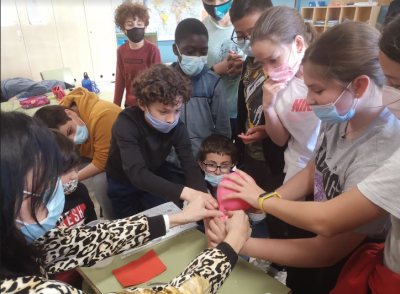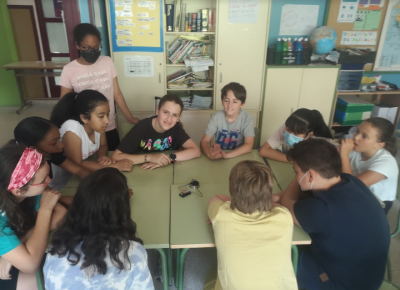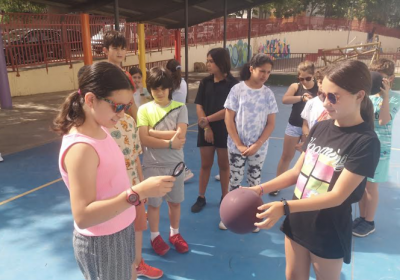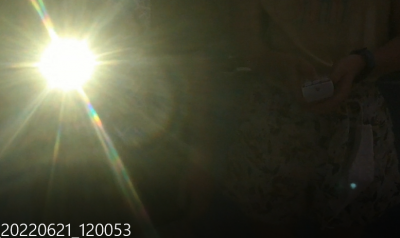
We observe that the balloon is filled with gas Can we demonstrate inside the balloon there is gas? Can we pour the gas in a jar and use it to put out a candle? We can put down the fire using the gas because it is CO2 and this gas does not allow the fire to be on. The balloon inflates very quickly. We pour the gas on the candle and …¡The candle goes out! My hypothesis was correct/incorrect. The gas stays inside the jar and we can pour it on the candle in order to put it out.

Make an Observation We have observed a compass pointing to the North. Observamos que la brújula siempre señala el norte. Ask a Question Can we change its direction? ¿Podemos cambiar su dirección? 2.CAn we make the same without using a magnet? Make a Hypothesis 1.No, because a compass always points to the North because the Earth has magnetism. No, porque una brújula siempre señala el norte porque la tierra tiene magnetismo. 1. Yes, we can change its direction using a magnet. Sí,podemos cambiar su dirección usando un imán. ___________________________________________________ 2. No, we can’t change the the direction of the compass without a magnet. 2. No podemos cambiar la dirección de la brújula si no usamos un imán. Conduct your Experiment Materials 4.5 V battery Electric wires (1) Crocodile clips A coil (bobina eléctrica) A magnet Procedure Wire 1: Place one extreme of a wire to the battery. Coloca un extremo del cable en la pila. Connect the other extreme to the other part of the battery. Conecta el otro extremo del cable en la pila. Place the wire on the compass. Pon la bobina de cable encima de la brújula. Observe Report your Results The compass doesn’t point to North. La brújula no señala el norte. Draw Conclusion We have created a magnetic field. So the magnet of the compass doesn’t know where to point because there are two magnetic fields next to it. The compass becomes “crazy”. Hemos creado un campo magnético asi que, la brújula no sabe donde señalar ya que tiene dos campos magnéticos cerca. El de la Tierra y el electroimán. La brújula se vuelve loca.

SCIENTIFIC METHOD EXPERIMENT: The mystery of the bursting balloons Make an OBSERVATION When we are dressed in black and it's very sunny we are very hot, but if we are dressed in white we are better. Ask a QUESTION Can we demonstrate dark colours absorb the heat better? Make a HYPOTHESIS __Yes, we can demonstrate it using balloons and a magnificent glass. __ No, we can't, because we can’t measure the temperature of colours. Conduct your EXPERIMENT Materials Different colours balloons. A magnificent glass. Sun glasses Procedure Inflate the balloons. Wear sunglasses. Place the magnificent glass between the balloon and the sun. Control the time until the balloon explodes. Compare the different times obtained by different colours. Report your RESULTS Light balloons took more time to explode, the darker is the colour the less time it needs to explode. Draw CONCLUSIONS We have demonstrated that dark colours absorb more energy (heat) than light colours because they don’t reflect any light, so they keep all the energy. That, makes dark balloons explode before light balloons.

The mystery of the unseen light 1 Make an OBSERVATION We observed we can see light from the sun or a lamp but not from a remote control. Ask a QUESTION Can we see invisible lights? Make a HYPOTHESIS ___Yes, we can. Using a special camera. ___No, we can’t because our eyes cannot see invisible light. Conduct your EXPERIMENT Materials Exp1: Infrared light A remote control A torch A transparent plastic A black plastic A mirror A camera Procedure Take the remote control and the torch Press some buttons on the remote control and switch on the torch. Can you see any light coming from the control? What about the torch? Repeat the exercise but place the camera opposite the torch and the remote control. Film the action. Repeat number 3 but pacing between the torch and the remote control different materials ( a transparent plastic, a black plastic, a mirror…) Observe Report your RESULTS When we don’t use the camera we can’t see the infrared light, but when we film the action with a camera the infrared light can be seen. Using different materials we observed both lights act in the same way, they can pass through transparent or translucent materials but they are reflected when you use a mirror. Draw CONCLUSION Infrared light can be seen if you use the correct receptor. Our eyes are not the correct receptors but a camera is. SCIENTIFIC METHOD EXPERIMENT: The mystery of the unseen light 2 Make an OBSERVATION We observed our skin can be burnt in summer and everybody says this is because of the ultraviolet rays of the sun. Ask a QUESTION Can we see UV rays? Make a HYPOTHESIS ____ No, we can’t. Because they are invisible to our eyes. ____ Yes, we can see them using a camera as it happened to the infrared light. Conduct your EXPERIMENT Materials Beads sensitive to ultraviolet light Small transparent plastic bags Factor 20 sun cream Factor 50 sun cream Moisturising cream Procedure Separate the beads into 3 small plastic bags that are properly closed. Mark each bag with the kind of sun cream you are going to use and cover it with the cream. Cover the first bag with factor 50 sun cream. Cover the second with factor 20 sun cream. Cover the last bag with moisturising cream Once the bags are prepared, expose them to sunlight for 1 or 2 minutes and observe what happens Report your RESULTS _ The beads in the bag with factor 50 sun cream didn’t change their colour. _ The beads in the bag with factor 20 sun cream changed a little bit their colour. _ The beads in the bag with moisturising cream change their colour to purple. Draw CONCLUSION Our hypothesis was not correct because we could not see the UV light although we can see its effects.